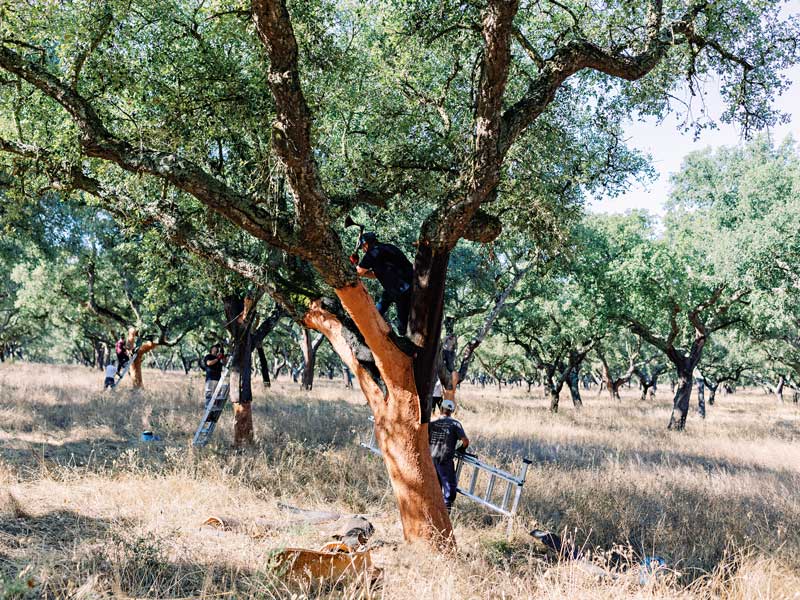
© Amorim
Author: Antonio Rios de Amorim, CEO and President of Corticeira Amorim
Cork is one of the most remarkable natural materials. It is a renewable, biodegradable and versatile resource, harvested cyclically without damaging the trees from which it comes. It grows in the Mediterranean, where for centuries cork oak forests have not only supported a diverse ecosystem, but also acted as vital carbon sinks, capturing large amounts of CO2.
Recognized as Global FinanceThe most sustainable company in the wine products industry, at Amorim our role has been to take this naturally sustainable material and find innovative new applications for it. Although best known for corks, which we produce at a scale of over 5.6 billion per year, cork is used in increasingly diverse industries. Our work ranges from creating products for the aerospace sector to environmentally friendly sports infills, demonstrating the adaptability and potential of cork beyond its traditional uses.
Innovate with every cap
One of the key areas of our activity remains the production of corks for wine, spirits and sparkling wines. Every day, we manufacture more than 22 million caps, serving markets including France, Italy and the United States. But it’s not about quantity: our research and development team continues to refine the quality and sensory performance of these closures, ensuring they meet the highest standards.
An essential part of our sustainable development actions involves responsible forest management.
A major advance has been our ability to produce corks with non-detectable levels of the molecule Trichloroanisole (TCA), a compound that can affect wine. This achievement combines traditional know-how, scientific research and innovation, for the benefit of winegrowers and consumers.
Cork processing companies play a driving role in creating an economic interest allowing forest owners to maintain their properties. As such, the production of corks, as the most valued product in this ecosystem, makes a significant contribution to climate change mitigation, making it a much more sustainable choice than alternatives such as cork stoppers. aluminum or plastic.
A key principle of our operations is to ensure that no part of the cork is wasted. Any cork that isn’t used for corks is reused in other applications, from flooring and insulation to advanced materials for industries like aerospace. This approach allows us to operate in a 100% circular economy, where every by-product is transformed into something valuable.
Amorim Cork Composites is an excellent example of how this circular economy works. By-products from cork manufacturing are crushed and used to develop innovative products, demonstrating that sustainability and innovation can go hand in hand. With the growing demand for sustainable materials in various industries, we are constantly exploring new applications for cork.
Forest management and climate action
Our work is not limited to what happens in the factory. An essential part of our sustainable development actions involves responsible forest management. Cork oak forests not only provide the raw material we need, but also play an essential role in CO2 capture. We have implemented innovative practices to make cork oaks more resilient to climate change, pests and diseases, while planting new forests and improving the health of existing forests.
In fact, through a combination of research and intervention, we are working to reduce the time it takes to first harvest cork from 25 years to just 10 to 12 years. This increases the economic interest and viability of the forest.
For each ton of cork harvested, the forest is capable of sequestering up to 73 tons of CO2
Cork oak forests are one of the world’s natural carbon sinks: for each ton of cork harvested, the forest is capable of sequestering up to 73 tons of CO2. This ability to capture carbon and retain it for long periods of time, since the tree is not cut down and lives an average of 200 years, makes cork one of the most environmentally friendly materials available today. .
According to a life cycle analysis carried out by PwC Naturity, corks are significantly superior to artificial closures in five of the seven indicators analyzed. Namely the consumption of non-renewable energy, the production of solid waste, the contribution to the formation of photochemical oxidants and the contribution to the eutrophication of surface waters and greenhouse gas emissions. These findings strengthen cork’s position as a sustainable material with significant environmental benefits, including reducing our carbon footprint.
More than 150 years of history
Corticeira Amorim is the world’s largest cork exporter and the world’s oldest cork company in continuous operation since 1870. We are also the world’s largest cork processing company, with a presence in almost 30 countries on five continents and the largest distribution network in the world. sector. We have a diverse customer base of over 30,000 customers and over 93% of our sales are made outside of Portugal, where we are based.
Sustainability is deeply rooted in Corticeira Amorim’s DNA, and we are proud to see our efforts recognized with this award, which highlights our commitment to efficient resource management, sustainable consumption, circularity of processes, the protection of ecosystems and the development of our employees.
